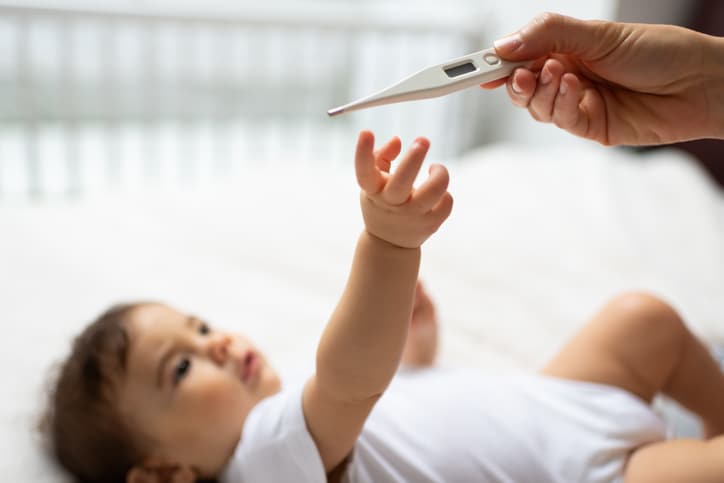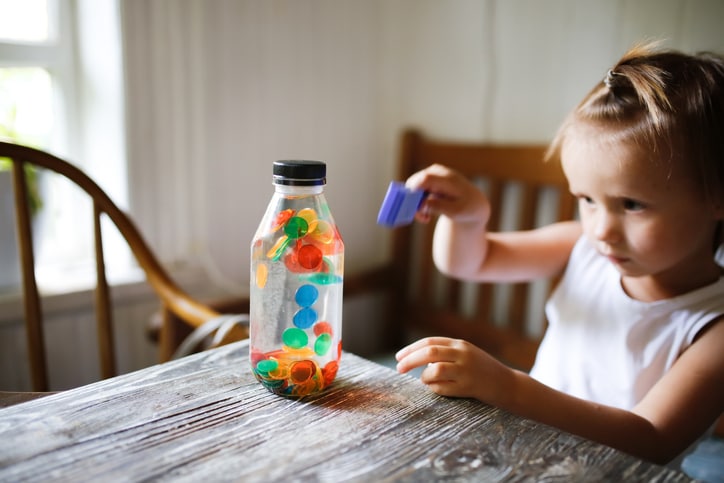If you’re a parent or caregiver, there’s a good chance that, when it comes to taking little ones’ temperatures, you’re well-versed in the how-to. But do you know how often you should check a child’s temperature when they’re under the weather?
Parents and caregivers should check a child’s temperature when they’re acting abnormally, according to Dr. Catherine Mims, a pediatrician at Oklahoma Children’s Hospital OU Health. “Generally, there is no prescribed frequency for taking a child’s temperature,” she says. “Rather, it should be based on how they’re acting. Parents and caregivers should check a child’s temperature if they’re particularly fussy, irritable, more tired than usual, if they are not eating their normal amount or if they feel particularly warm.”
That being said, when it comes to fevers in babies under 2 months of age, parents should be more vigilant (more on this in a bit). Here’s everything you need to know about how often you should check a child’s temperature.
How often to take a baby’s temperature
“There is no need to check for fever on a regular basis if your child has no symptoms,” says Dr. Tomitra Latimer, medical director at Lurie Children’s Pediatrics at Deming. With illnesses, like COVID and flu, it’s a good idea to check for a fever if they’re coughing or have a runny nose, she adds. Additionally, if your child feels warm to the touch at any time, it is important to formally check for a fever using a thermometer.
It’s important to note that “fever is very common,” Latimer adds. “Fever is a sign that the body is fighting off viruses.”
“It is always important to have a heightened sense of awareness for a fever in an infant under 2 months of age. If your newborn appears ill, checking for fever every two to four hours would be appropriate.”
— Dr. Rachel Prete, pediatrician
Exception for babies under 2 months old
While the frequency with which you take a child’s temperature is based more on how they’re acting than an exact formula, when it comes to babies 2 months and younger, parents and caregivers should be extra watchful.
If your infant has a fever of 100.4 or higher, it’s important to call their health care provider for “further direction, as a fever in a newborn is considered an emergency,” says Dr. Rachel Prete, a pediatrician with Orlando Health.
“It is always important to have a heightened sense of awareness for a fever in an infant under 2 months of age,” Prete explains. “If your newborn appears ill, checking for fever every two to four hours would be appropriate. If a baby does not have a fever, but appears ill, monitor the infant very closely to make sure they are continuing to feed appropriately.”
If you have questions about how often to check infant temperature or are at all concerned about an infant’s symptoms, you should contact the pediatrician, she adds.
How long to wait between temperature checks
If a child has a fever — which, according to Latimer, is a temperature of 100.4 F or higher, no matter their age — parents or caregivers can administer a fever-reducing medication and then “check to see if it’s working about 15-20 minutes later.” After that, parents can take the child’s temperature when they “feel warm again.”
Mims adds that if a child has a fever, but they’re acting relatively normally and are drinking enough to stay hydrated, fever-reducing medication isn’t necessary, as fever “helps to combat the bacteria or virus the child is fighting.”
The best way to check a baby or child’s temperature
Thermal scanner thermometers may be more ubiquitous than ever, but they’re not necessarily the best way to check for fever, particularly when it comes to babies. “If you have an infant who is under the age of 2 months, who begins to appear ill, it’s important to check their temperature rectally,” Prete says. “We do not recommend thermal scanners or ear thermometers in that age, as they can be inaccurate.”
“Parents or caregivers can use a thermometer under the arm for screening for fever in babies, but one degree should be added to the temperature reading,” Prete continues. “For instance, if your 1-month-old has an axillary [underarm] reading of 99.6 F, their temperature could be 100.6 F. At that time, you would need to confirm the temp with a rectal reading.”
“Parents or caregivers can use a thermometer under the arm for screening for fever in babies, but one degree should be added to the temperature reading.”
— Dr. Rachel Prete
Mims adds that in babies 12 months old and younger, it is most accurate to take their temperature rectally. “Over 12 months old, axillary temperatures are acceptable,” she says. Latimer says that temperatures obtained via “digital thermometers in the mouth” are OK once kids hit 5 years of age.
How often should I check my child’s fever at night?
Since time doesn’t stop when a child is sleeping, many parents wonder if they should check a baby’s temperature when they’re sleeping. The answer: It depends on the child. “If it is difficult to obtain a temperature in an infant or toddler when they’re up and moving around, parents can consider checking for fever while the child is sleeping,” Latimer says. “Otherwise, it is fine to just check when they’re awake.”
When to call the doctor about a fever
According to Mims, the actual number of the fever is not necessarily an indicator or when to call the doctor, as “even viral illnesses can cause high fevers.” “These temperatures are well tolerated by children as it is a shift made by their own bodies in temperature,” she says. “However, if the fever is greater than 100.4 F in infants under 2 months old, it is a medical emergency and the child needs to go to the emergency room immediately.”
Other reasons to the call the doctor for a fever, according to Mims, Prete and Latimer:
- The fever lasts more than five days and is not improving.
- The child appears ill, along with the fever.
- The child doesn’t perk up when the fever breaks.
- The child has difficulty breathing or is working harder to breathe (this should warrant a call to the doctor whether or not a fever is present).
- The child isn’t drinking well.
- The child isn’t having wet diapers.
The bottom line
“Overall, a fever in a child is not harmful to them,” Prete assures. “It is the body’s natural response to fighting infection. We mostly treat fevers in children because fever makes them feel uncomfortable; but in general, there is no certain height of a fever that should cause more concern than the other, as different infections can cause different elevations in temperature.”




